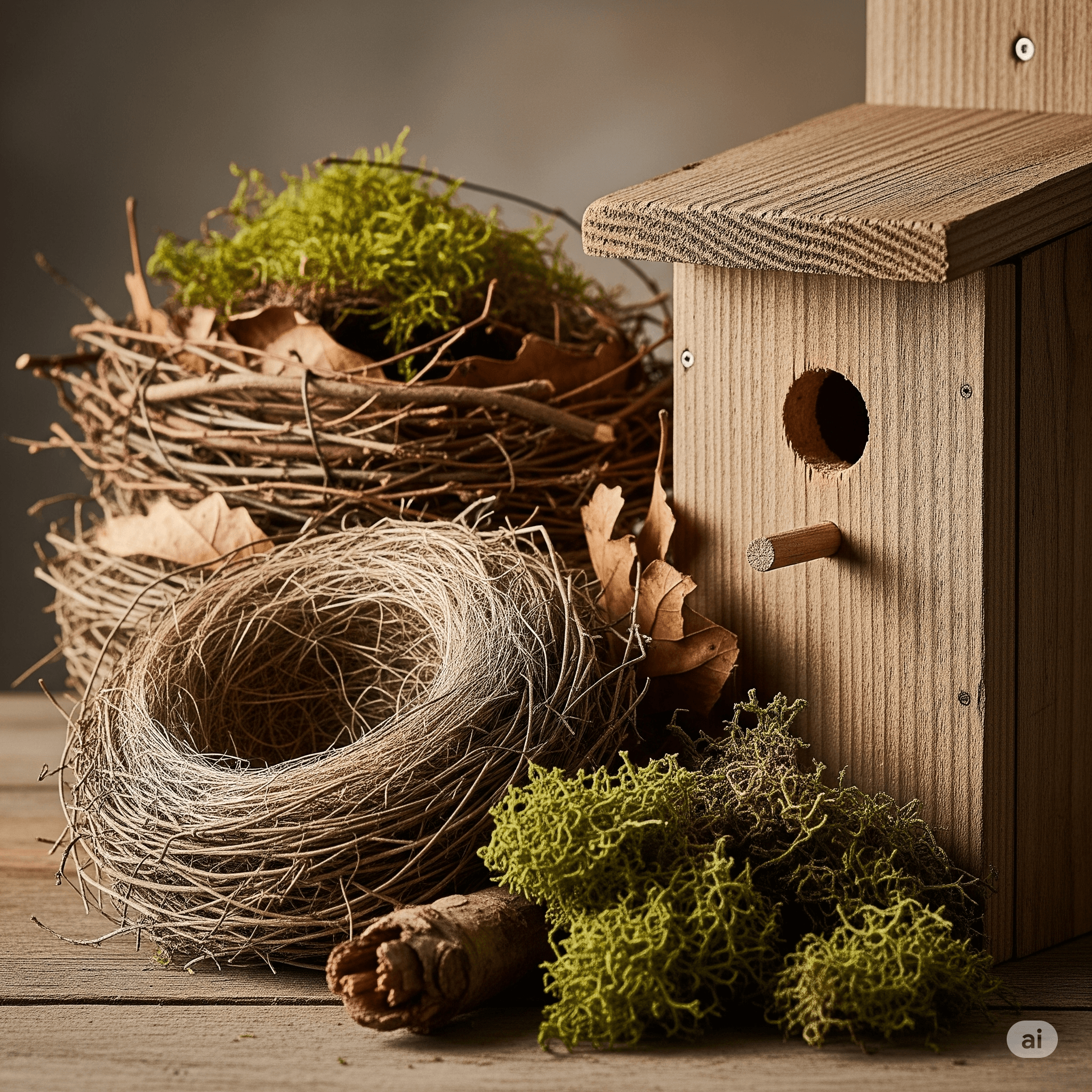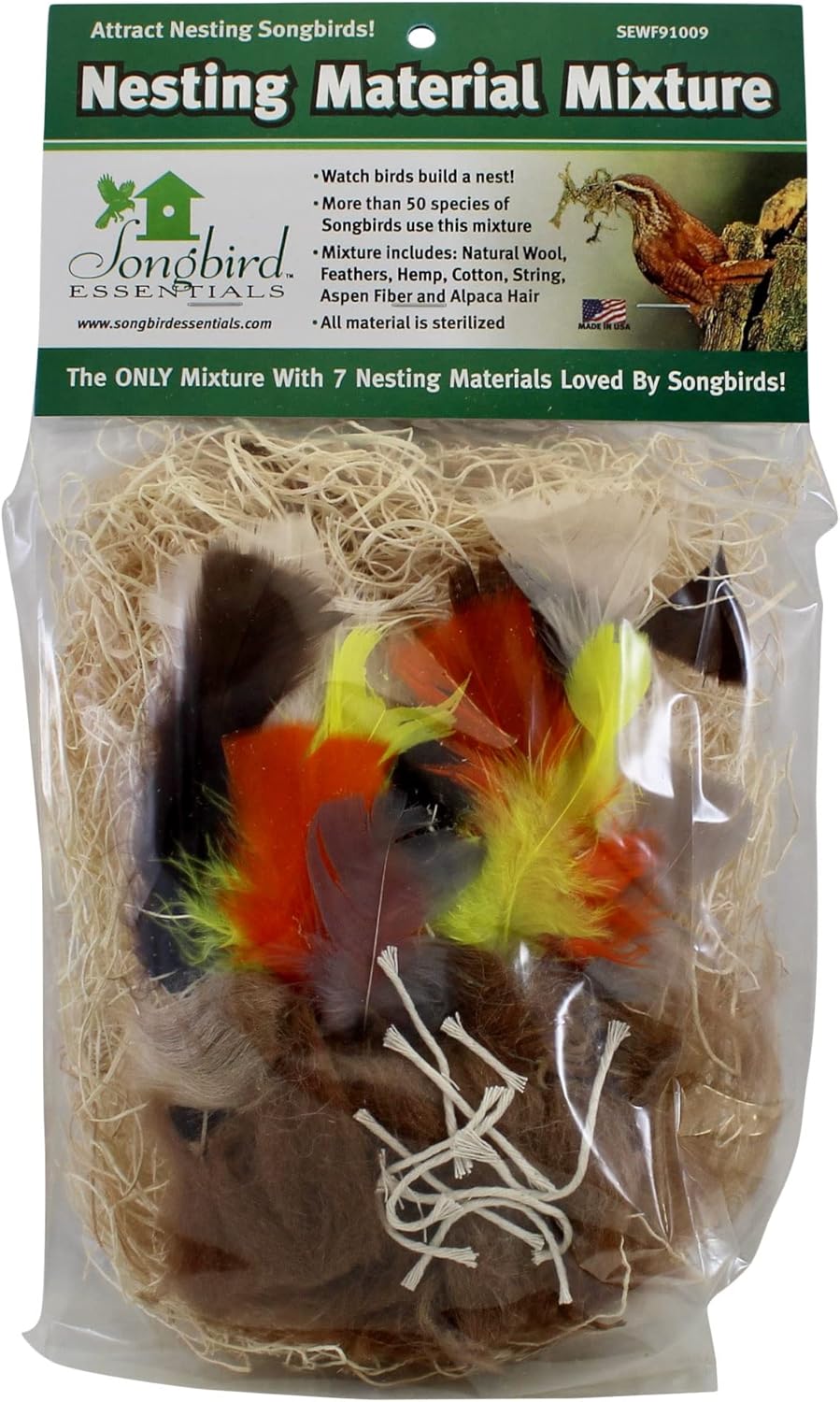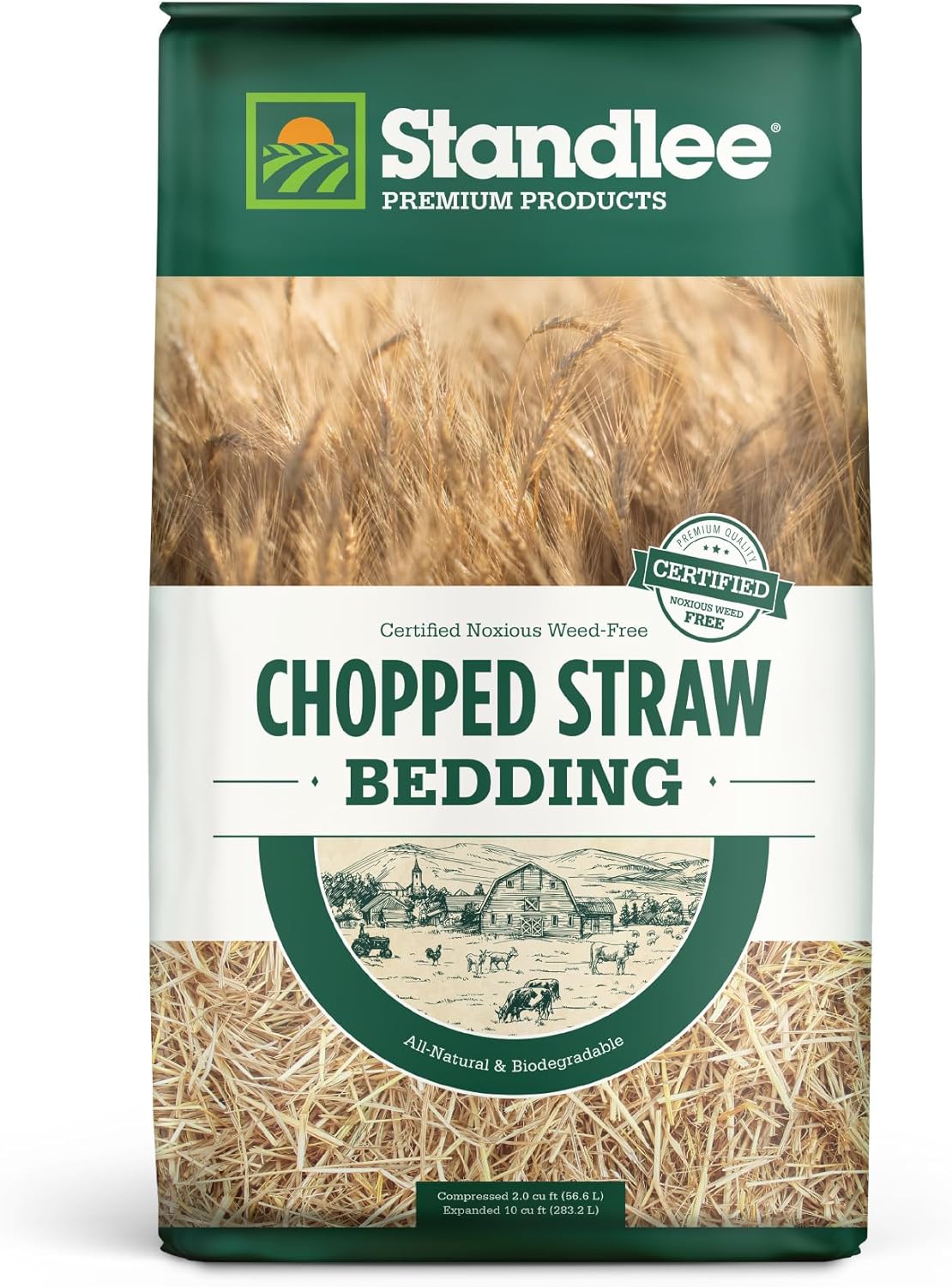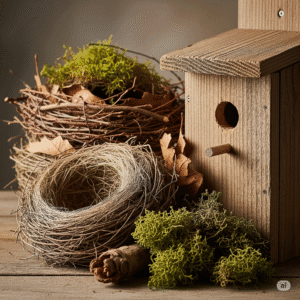What to Put Inside a Birdhouse: The Surprising Answer for Happy Nesters

As a backyard birder, there’s nothing more rewarding than seeing a birdhouse you’ve carefully placed become a bustling home. You watch a pair of birds inspect the property, then diligently start carrying in materials. It’s a sign of success! This naturally leads to a thoughtful question: “Is there anything I can put *inside* the birdhouse to make it even more comfortable and attractive for them?”
I’ve been asked this countless times over my two decades of creating wildlife habitats. We want to be good hosts, to give our feathered friends a five-star experience. The desire to line the box with something soft and warm comes from a good place. But here is the surprising, expert-approved answer that might go against your every instinct…
The Short Answer
For the vast majority of common backyard birds that use nest boxes (like wrens, bluebirds, chickadees, tree swallows), you should put absolutely nothing inside the birdhouse. Leave it clean, empty, and ready for them to customize.
The Why: Birds are instinct-driven architects. The act of gathering materials and building a nest is a critical part of their courtship and breeding cycle. A pre-filled box can confuse them, make them think it’s already occupied, or contain materials unsuitable for their species.
This guide will take a deep dive into the science and instinct behind nest building. We’ll explore why an empty box is best, the crucial exceptions to this rule for specific birds, and how you can *safely* help your local birds gather the best materials for their new home. Let’s build a better understanding, so they can build a better nest.
The Golden Rule: Let the Birds Be the Interior Designers
Imagine you’re house-hunting and every home you visit is already filled with someone else’s furniture. It would be confusing and off-putting. For birds, it’s a similar experience. An empty birdhouse is a blank slate, a perfect opportunity. A filled one is a potential problem.
Instinct, Courtship, and Construction
Nest building is not just about making a soft cup for eggs. It’s a complex, hardwired behavior that serves several purposes:
- Pair Bonding: For many species, the process of building a nest together strengthens the bond between the male and female. The male might bring materials to the female, who then does the intricate weaving. This teamwork is essential for successfully raising a brood.
- Species-Specific Architecture: A chickadee’s nest is vastly different from a bluebird’s. Chickadees create a soft cup of moss and line it with fur and soft fibers. Bluebirds build a tidy nest primarily of fine grasses and pine needles. They instinctively know what materials provide the right insulation, drainage, and structure for their eggs and young. Your well-intentioned cotton balls might be entirely wrong for their needs.
- Signaling Occupancy: An empty, clean cavity signals an available territory. A box with foreign material might suggest to a prospecting bird that another creature has already claimed it, causing them to move on without a second look. The process of filling the box is how they claim it as their own.
A Birder’s Observation: I once watched a pair of Carolina Wrens spend three days building an elaborate nest of twigs, moss, and leaves inside a box I had mounted near my porch. The sheer volume of material they brought in was astounding. This diligent work is a fundamental part of their natural cycle. If I had pre-filled the box, I would have robbed them of this essential process.
The Big Myth: Never Put Birdseed Inside a Birdhouse
This is perhaps the most common and dangerous mistake well-meaning people make. The logic seems sound: “I’ll put food where I want the birds to live!” But birdhouses are nurseries, not restaurants. Mixing the two is a recipe for disaster.
Adding seed, breadcrumbs, or any food will attract a host of unwelcome visitors and create a dangerously unsanitary environment. The scent of food can lure squirrels, raccoons, and mice that will not only eat the seed but also the eggs and nestlings. It also attracts ants and other insects. Furthermore, uneaten seed will quickly grow mold and bacteria in the enclosed, humid space of a nest box, which can be fatal to a developing brood. Your goal of attracting birds can quickly turn into a tragedy.
Keep your feeding stations separate from your nesting areas. Offering a high-quality food source, like one of the best bird seed mixes, is a fantastic way to support your local bird population, but do so at a safe distance from their homes.
How to Help: Providing Nesting Materials *Near* the Birdhouse
While you shouldn’t fill the box, you can be an invaluable “supplier” for their building project. Creating a nesting material station is a fun, safe, and effective way to help. It also provides incredible opportunities to watch birds select and fly off with your offerings.
You can offer materials in a clean suet cage, a small wire basket, or even just tucked into the bark of a tree. The key is to make them accessible.
✓ Safe & Recommended Materials
- Twigs & Pine Needles: The foundation for many nests. Bluebirds, in particular, love pine needles.
- Dried Grass & Leaves: Ensure they are pesticide-free. Avoid using fresh grass clippings which can rot.
- Moss & Lichen: Excellent for insulation and camouflage. Chickadees and titmice love moss.
- Feathers: A soft, luxurious lining. Tree Swallows are famous for lining their nests with white feathers.
- Natural Cotton/Wool: CRITICAL: Must be cut into pieces no longer than 1-inch to prevent entanglement.
- Mud Puddle: Robins and Barn Swallows need mud as a mortar. Keeping a small area of your garden damp can be a huge help.
✗ Dangerous & Harmful Materials
- Dryer Lint: Contains synthetic fibers that disintegrate when wet and may have chemical residues. A huge “no” from the Audubon Society.
- Human Hair & Pet Fur: Long strands are a primary cause of entanglement for nestlings, cutting off circulation to tiny legs and wings. Pet fur can contain flea/tick medication residues.
- Yarn, String, Fishing Line: Deadly entanglement hazards. Never offer these.
- Plastic, Tinsel, Cellophane: Unnatural materials that can be ingested or cause strangulation.
- Synthetic Fibers: Polyester, acrylic, and nylon don’t breathe and can lead to a damp, cold nest.
Product Pick: Nesting Material Station

Songbird Essentials Bird Nesting Material Holder
This simple, effective product takes the guesswork out of helping your birds. It’s a pre-filled wire globe with natural cotton, which is a favorite for many small songbirds for lining their nests. The design makes it easy for birds to pull out what they need. Once the initial material is used, you can refill it with other safe options like moss or short pieces of wool. It’s a fantastic visual aid for watching the nest-building process up close.
Check Price on AmazonExceptions to the Rule: When You *Should* Add Material
As with most rules in nature, there are important exceptions. Certain larger cavity-nesting birds do not build intricate nests and will abandon a box with a bare, hard floor. For these specific species, you need to give them a head start.
Woodpeckers, Owls, Kestrels, and Wood Ducks
These birds typically nest in tree cavities created by woodpeckers. A natural cavity has a built-in cushion of wood chips left over from the excavation. Your pristine, smooth-floored birdhouse doesn’t mimic this. Without a soft base, their eggs can roll around, break, or fail to incubate properly.
The Solution: For a birdhouse designed for Screech Owls, American Kestrels, or Wood Ducks, add a 2 to 4-inch layer of wood shavings (not sawdust) to the bottom of the box. This provides a necessary cushion for the eggs and helps keep them dry.
Expert Tip: Use pine or aspen shavings. Avoid cedar shavings, as the aromatic oils can be irritating to birds’ respiratory systems. Critically, **never use sawdust**. Sawdust can get wet, clump together like concrete, and can be inhaled by small nestlings, causing respiratory damage.
Understanding these exceptions is a key part of how to get birds to nest in your birdhouse, as it shows you are catering to the specific needs of the species you wish to attract.
Product Pick: The Right Nesting Material

Standlee Premium Western Forage Pine Shavings
While marketed for small animals, these premium pine shavings are perfect for preparing nest boxes for owls, kestrels, and wood ducks. They are all-natural, free from additives, and kiln-dried to reduce moisture and dust. A single bag will last you for years of birdhouse maintenance. This is the exact type of material recommended by conservation groups to create a safe and effective nesting base for these specific cavity nesters.
Check Price on AmazonBeyond Materials: Preparing the Perfect Birdhouse
A properly prepared birdhouse involves more than just its contents. It needs to be clean, safe, and welcoming. This is where many bird landlords can make a huge difference in their nesting success rates.
Annual Cleaning: A Non-Negotiable Task
After a brood has fledged, the old nest should be removed. It can be filled with parasites like mites and blowfly larvae, as well as fecal matter and bacteria. Leaving it in place creates an unhealthy environment for the next residents. A clean-out in the fall also prepares the box to be used as a safe, warm roosting spot during the harsh winter months, which helps answer the question of do birds sleep in the same place every night? A clean, empty box provides a critical sanctuary.
Predator Protection: Your Most Important Job
An unprotected birdhouse can quickly become a death trap. Installing the best birdhouse entry protectors can stop woodpeckers from enlarging the hole, and mounting the house on a pole with a baffle is the gold standard for stopping climbing predators like raccoons and snakes.
For more details, our complete collection of birdhouse reviews always considers safety and maintenance features, helping you choose a box that is not only attractive but also safe and easy to care for.
Frequently Asked Questions (FAQ)
Should I put anything in a birdhouse for winter?
For most small songbirds, no. Leave the box clean and empty. They will use it for roosting (shelter from cold and predators). The exception is for larger birds like owls; for them, you would have already added wood shavings. A clean, empty box is the best winter shelter you can provide.
How can I tell if a bird is using my birdhouse?
Observe from a distance. The most obvious sign is seeing a bird repeatedly carrying nesting material into the box. You may also see the pair perched nearby, guarding the territory. Once the female lays eggs, activity might decrease, but soon you’ll see the parents flying back and forth constantly with food for the babies.
What about gourds for birdhouses? Do they need anything inside?
The same rules apply. Natural gourds, which are detailed in our guide to the best birdhouse gourds, should be left empty for species like Purple Martins and wrens. They will bring their own materials.
When is the best time to put up a birdhouse?
The best time is in the late fall or winter. This gives the birds plenty of time to find it and check it out before the breeding season starts in the spring. It also allows the scent of humans to fade from the box. Understanding a bird’s 24-hour clock and seasonal rhythms helps you time your efforts for maximum success.
Conclusion: Trust in Nature’s Wisdom
The desire to fill a birdhouse comes from a place of kindness, but the most helpful action is to step back and let the birds’ powerful instincts take over. By providing a clean, safe, and empty house, you give them the perfect canvas on which to create their home.
Your role as a backyard conservationist is that of a provider and a guardian. Provide the right kind of house in the right location. Provide safe materials nearby. And guard that house fiercely against predators. Do these things, and you’ll be rewarded with the unparalleled joy of watching new generations of birds begin their lives, right in your own backyard.

